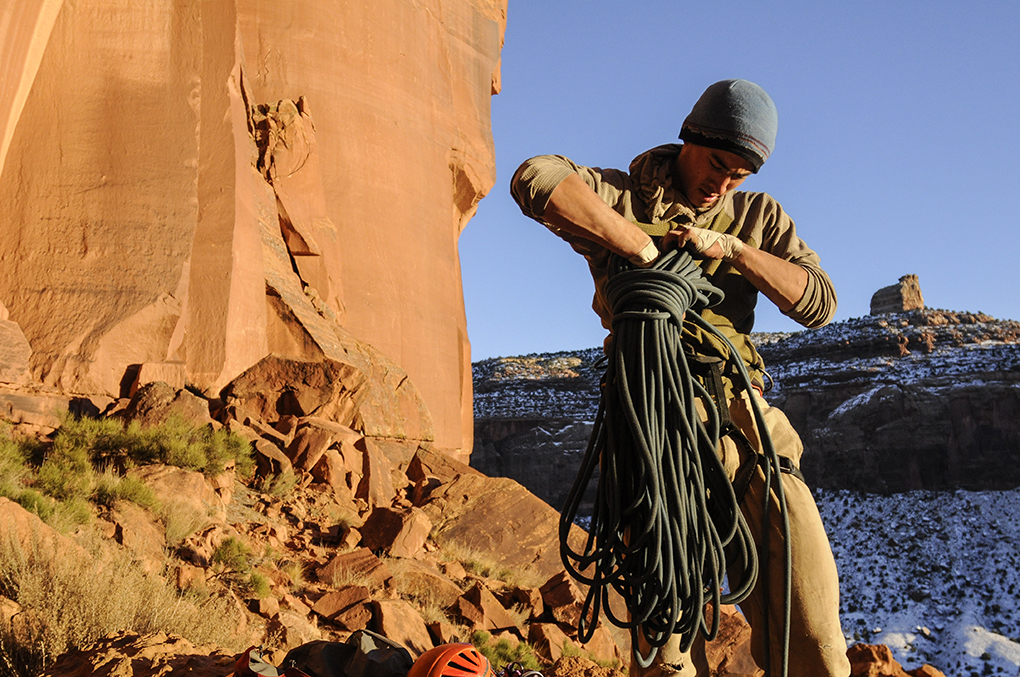Dirt Resistance
Over the course of a month in the desert, the Contact accumulated more dirt more quickly than a dry-treated rope, as one would expect. The dirt accumulation did adversely affect the handling; towards the end of the trip, the rope was noticeably stiffer than when it was fresh out of the box.
Upon reintegrating into civilization at the end of the trip I washed the rope and did see an improvement in the handling when I got all the dirt out. The lesson, as always: use a rope bag to prolong the life of a rope by keeping it out of sand and dirt, especially in areas like Indian Creek.
Middle Mark
The middle of the Contact is marked with a thick black strip of ink, a technique Petzl uses on all their ropes. I have not noticed any fading of the middle mark, but on a darker colored rope (blue in my case), the mark blends in quickly once the rope gets dirty. I have an older Petzl Fuse 9.4mm rope that is bright orange, and the middle mark is still highly visible after a full year of use.
After using the Metolius Monster rope and the Mammut Sensor, both of which have middle marks woven into the sheath, I find that tactile middle marks have more longevity and better visibility when dirty, than a simple colored mark.
Durability
Traditionally, there is a bit of a trade-off between a rope’s handling and its durability: the softer the rope, the faster it wears out.
I have worn out a soft Mammut 9.3mm rope in less than a season. On the opposite end of the spectrum, Hannah Trim still climbs on an old Edelwiss 10.2mm rope that is about three years old and has no sheath damage or soft spots—but it is about as stiff as steel wire.

The Contact 9.8 walks a fine line between the two. After a month in the Creek, the sheath of the Contact still looks pretty fresh. It shows only minimal fuzzy spots, and the only significant spot of wear was a direct result of ascending up a pitch to shoot pictures. I don’t hold this wear against the Contact though, since ascending is something that should usually be done on a static rope and not on a dynamic rope like the Contact anyway. The core of the Contact 9.8 still feels solid, with no soft spots to indicate internal damage.
Comparisons
This year Petzl made the decision to completely revamp their line of ropes. This is certainly not unheard of, but it is uncommon. More importantly, though, they also made the decision this year to end in-house production of their ropes, choosing to source production out to Edelrid, another European company with a long history of making ropes.
Although I can’t comment on the reasoning behind this decision or the specifics of each company’s manufacturing process, I have used previous-generation Petzl and Edelrid ropes, in addition to Petzl’s new Contact 9.8, so I can comment at least a bit on the three.
I personally have used a Petzl Fuse 9.4mm (previous generation Petzl), Edelrid Boa 9.8mm, and the Petzl Contact 9.8mm. The older Petzl-manufactured Fuse, although it is a smaller diameter rope, feels stiffer than either of those 9.8mm ropes.
Prior to using the Contact, if you had asked me what my favorite 9.8mm rope was, I would have answered with either the Sterling Velocity or the Edelrid Boa. However, my experience with the Petzl Contact leads me to believe it is an almost identical rope to the Edelrid Boa, especially since they are produced by the same manufacturer.
Bottom Line
The new Petzl Contact 9.8 is a smooth handling and durable workhorse rope for everyday use on everything from top-roping to redpoint attempts.
There are better specialty ropes out there—both on the thicker and thinner ends of the spectrum—but the Petzl Contact 9.8 walks a nice line, providing much of the durability of a thicker rope along with the smooth handling of a thinner line.
